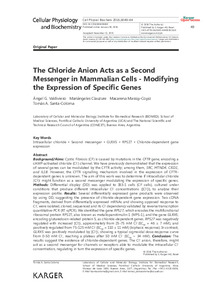Please use this identifier to cite or link to this item:
https://repositorio.uca.edu.ar/handle/123456789/1454| Título: | The chloride anion acts as a second messenger in mammalian cells modifying the expression of specific genes | Autor: | Valdivieso, Ángel Gabriel Clauzure, Mariángeles Massip Copiz, María Macarena Santa Coloma, Tomás Antonio |
Palabras clave: | GENETICA; BIOLOGIA CELULAR; CLORURO INTRACELULAR; FIBROSIS QUISTICA; BIOMEDICINA; SEGUNDO MENSAJERO; BIOLOGIA MOLECULAR; GENES CFTR DEPENDIENTES | Fecha de publicación: | 2016 | Editorial: | Karger International | Cita: | Valdivieso, A. G. et al. The chloride anion acts as a second messenger in mammalian cells modifying the espression of specific genes [en línea]. Cellular physiology and biochemistry. 2016, 38. Disponible en: https://repositorio.uca.edu.ar/handle/123456789/1454 | Resumen: | Abstract: Background/Aims: Cystic Fibrosis (CF) is caused by mutations in the CFTR gene, encoding a cAMP-activated chloride (Cl-) channel. We have previously demonstrated that the expression of several genes can be modulated by the CFTR activity; among them, SRC, MTND4, CISD1, and IL1B. However, the CFTR signalling mechanism involved in the expression of CFTRdependent genes is unknown. The aim of this work was to determine if intracellular chloride (Cl-Clconcentration, regulating in turn the expression of specific genes | URI: | https://repositorio.uca.edu.ar/handle/123456789/1454 | ISSN: | 1421-9778 | Disciplina: | MEDICINA | Derechos: | Acceso Abierto | Fuente: | Cellular Physiology and Biochemistry 38, 2016 |
| Appears in Collections: | Artículos |
Files in This Item:
| File | Description | Size | Format | |
|---|---|---|---|---|
| chloride-anion-acts-second-messenger | 2,46 MB | Adobe PDF |  View/Open |
This item is licensed under a Creative Commons License

